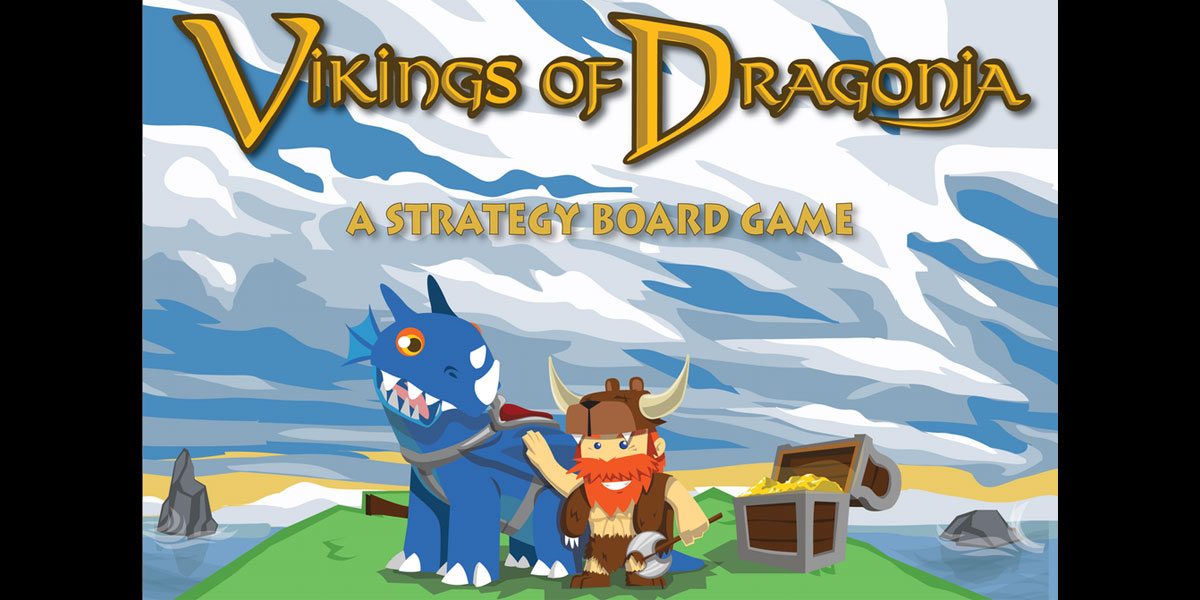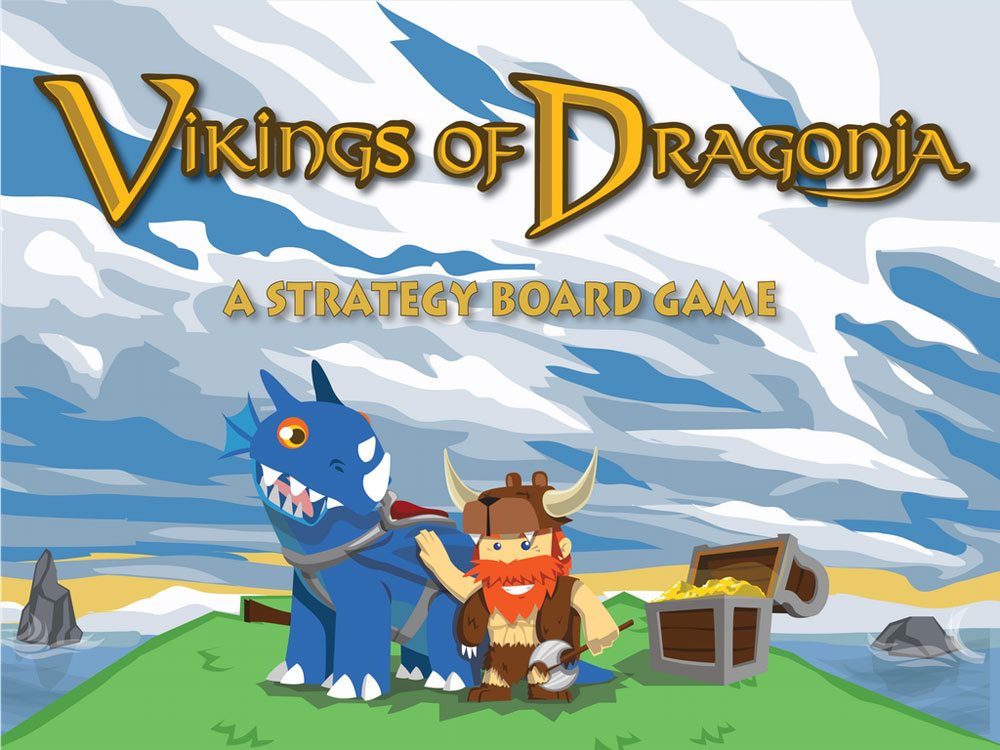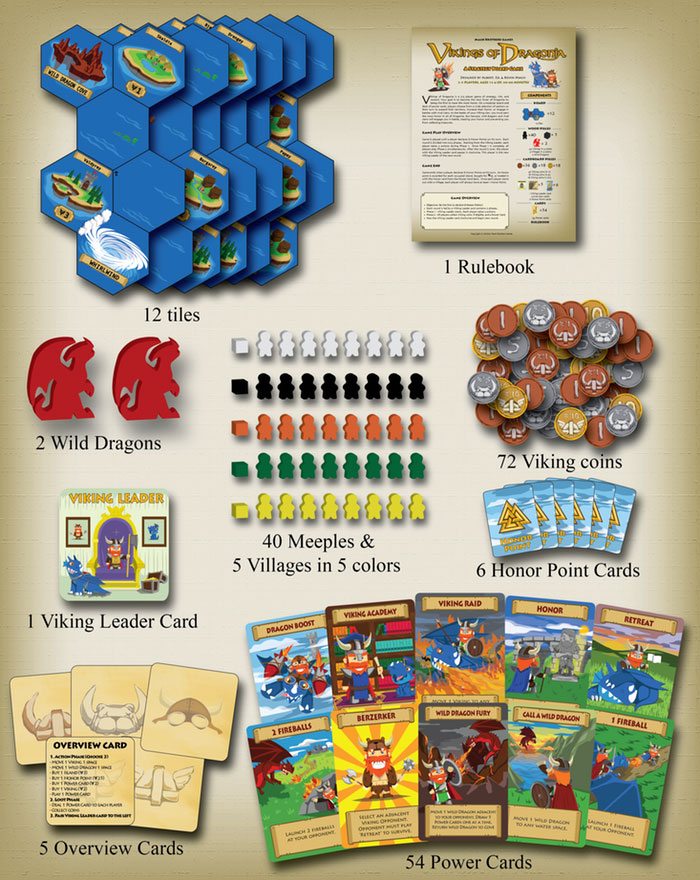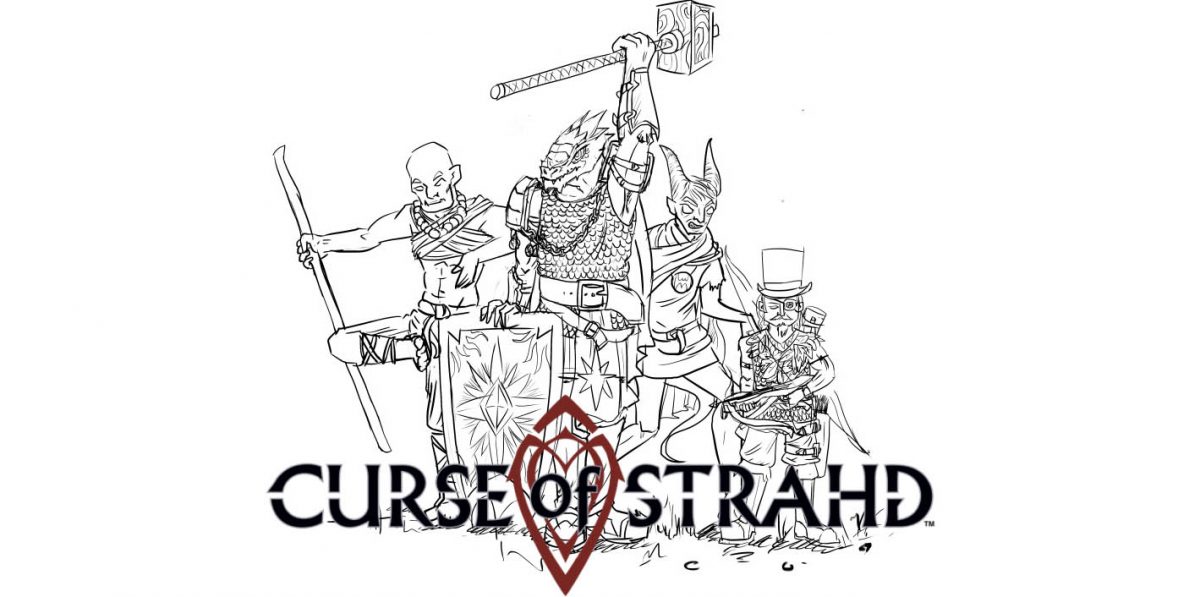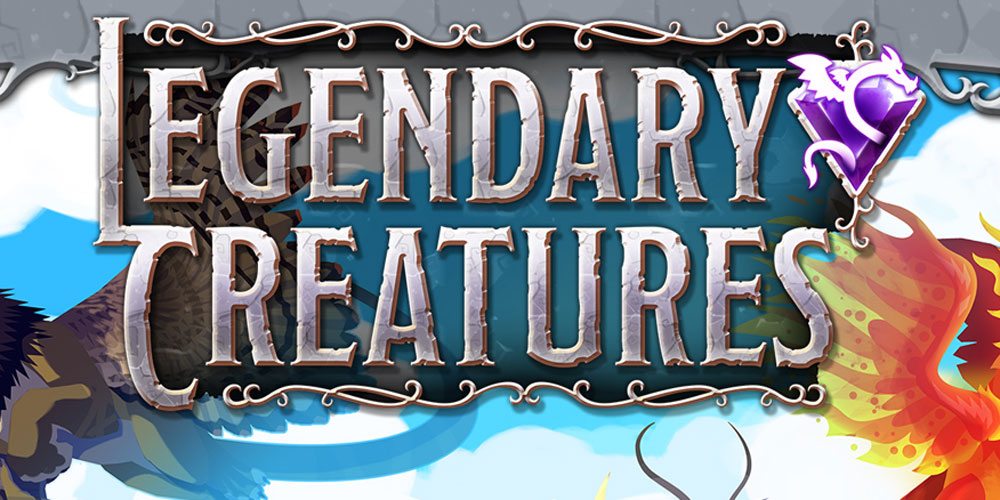Ah, Dragonia, a land where Vikings and dragons live in harmony … well, sort of. You see, the Viking clans are all trying to become the next rulers of Dragonia, so they’re constantly battling each other with the help of their trained dragons. You’ll need lots of territory if you want to rule over the Vikings of Dragonia.
At a glance: Vikings of Dragonia is for 2 to 5 players, ages 13 and up, and takes 30-60 minutes to play. I think the rules are easy enough that you could play with younger players if they have some experience with tactical games–there’s nothing content-wise that is inappropriate. The game is currently seeking funding on Kickstarter, with a pledge level of $42 for a copy of the game.
Not familiar with Kickstarter? Read our crowdfunding primer here.
Components
As shown in the image above:
- 12 board tiles
- 2 Wild Dragon figures
- 40 Meeples (8 each in 5 colors)
- 5 Villages (1 each in 5 colors)
- 72 Viking coins (in denominations of 1, 5, 10)
- 54 Power cards
- 6 Honor Point cards
- 5 player aid cards
- 1 Viking Leader card
I received a prototype of Vikings of Dragonia to try out, so the components were not final quality, but the artwork was complete. The board tiles are each made of six hexes, and they fit together to make the board. They are marked to indicate which to use depending on the number of players.
The Wild Dragon figures are wooden cutouts, and they’re cute but because of the proportions I found they tended to tip over, so we usually just left them on their sides.
The artwork on the Power cards is pretty cute–that’s gotta be the most adorable Berzerker you’ve ever seen, right? And the dragons are pretty cute, even when they’re breathing fire and burning everything down.
How to Play
You can download a copy of the rules here, or even get a Print and Play to try it out yourself.
The goal of the game is to achieve 8 Honor Points during your turn–you get 1 Honor Point for each island that you currently occupy, plus there are Honor Point cards which can be purchased. Note you have to have all 8 Honor Points during your turn–points do not accumulate between rounds.
To set up, you find the board tiles that correspond to the number of players, and then lay them out, two to a row, to form a roughly rectangular board. The wild dragons are placed on the Wild Dragon Coves (there’s only one cove in a 2-3 player game). Each player gets 5 coins plus the village and meeples of one color. One player takes the Viking Leader token. In turn order, each player places a village and a meeple on an island, but you can’t choose an island next to a Wild Dragon Cove.
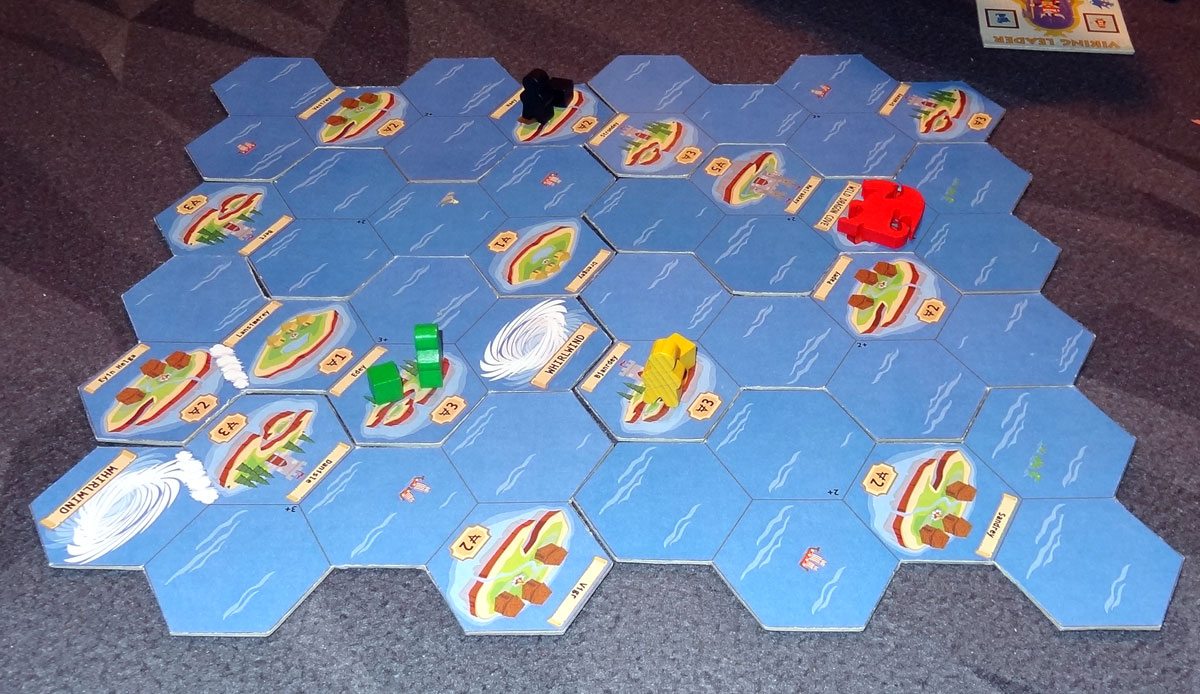
During each round, there’s a player phase when everyone makes their actions, then a loot phases when everyone collects income and gets cards. Then the Viking Leader card is passed clockwise, and a new round begins.
On your turn, you get three actions. You may:
- Movement: Move 1 Viking or 1 Wild Dragon to an adjacent space. Each space may hold up to 3 Vikings, but Vikings from different clans may not occupy the same Island space. Wild Dragons may only be in the water or their cove. Whirlwind spaces are all considered adjacent to each other.
- Buy Island: To move onto an unoccupied island, you must first pay 3 coins to the bank. If you leave an island, you’ll have to pay again if you want to move back onto it.
- Buy Honor Point: You pay 25 coins to the bank, and take an Honor Point card. Honor Point cards cannot be taken away, and do not count toward your hand limit.
- Buy Power card: Pay 2 coins to the bank and draw a card.
- Buy Viking: Pay 2 coins to the bank, and place a Viking meeple onto your village.
- Play Power card: Play a card and do what it says. Some cards specify that they do not require an action to play. Fireball cards will begin a battle, and the entire battle counts as a single action regardless of how many cards are played.
You may do the same action more than once.
Wild Dragons do a couple of things. First, the spaces adjacent to them cannot be attacked, so they become safe zones. However, they also prevent you from looting islands that are adjacent to them. So there’s a trade-off for moving a dragon near an island.
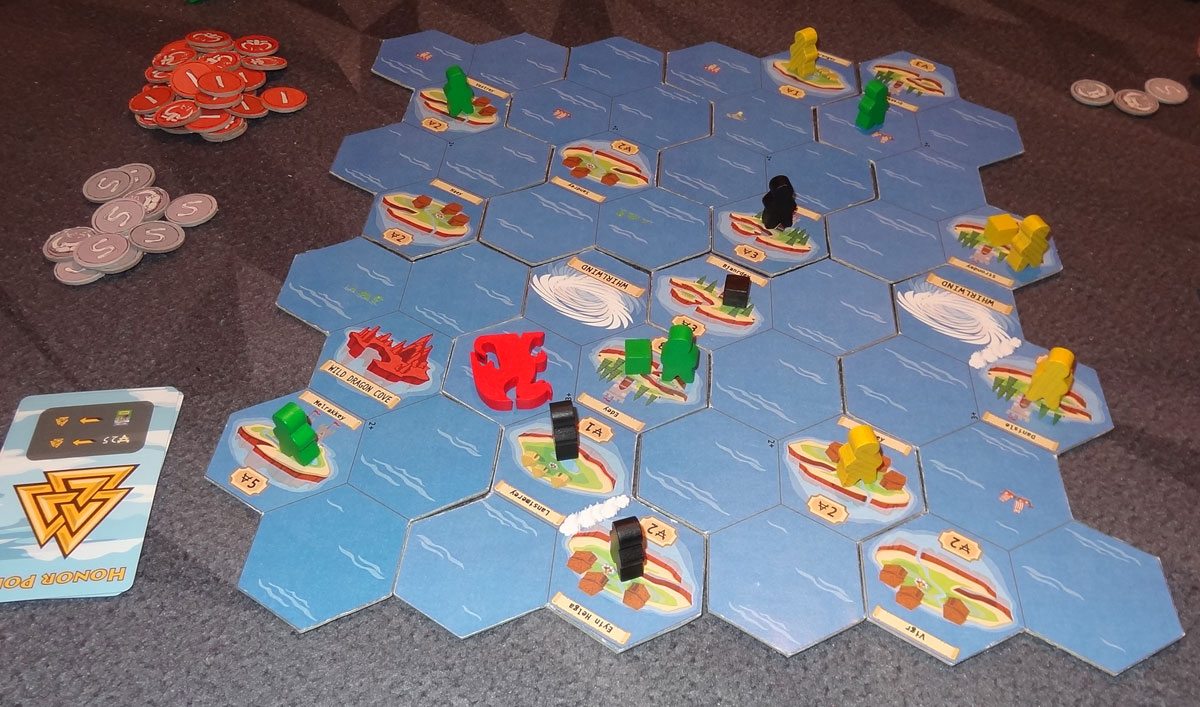
After each player has taken their three actions, then you move to the loot phase. Each player gets coins for the islands they occupy, as indicated on the islands. You always collect income from your village, even if you don’t have any Vikings on it and regardless of the Wild Dragons. For other islands, however, you cannot collect income if there is a Wild Dragon next to them. Also, each player draws a Power card–if you have seven or more cards, you don’t get to draw. Then the Viking Leader card is passed.

This wouldn’t be a Viking game without attacks, right? That’s where the Power cards come in. If you’re adjacent to or in the same water space as another Viking, you can start a battle by playing a fireball card–these come in either 1 or 2 fireballs. The defending player may play fireballs to match or exceed yours, and you go back and forth until somebody is unable to match the other player’s fireballs. Playing a retreat card lets you return the losing Viking back to your village. Otherwise, the losing Viking is removed and put back into your supply.

There are several other types of Power cards, too. Some will let you move Wild Dragons or Vikings quickly. Dragon Boost gives you a free action, and Viking Academy gives you a free Viking in your village without spending any actions or money. The Berzerker card is a special attack that’s an automatic win–the other player must play a Retreat card to go back to the village, or remove the Viking.
The Wild Dragon Fury lets you move a Wild Dragon anywhere, and then attack an opponent. You flip the top five cards, one at a time, and the defender must respond to any that are fireballs. Then the Wild Dragon goes back to its cove.
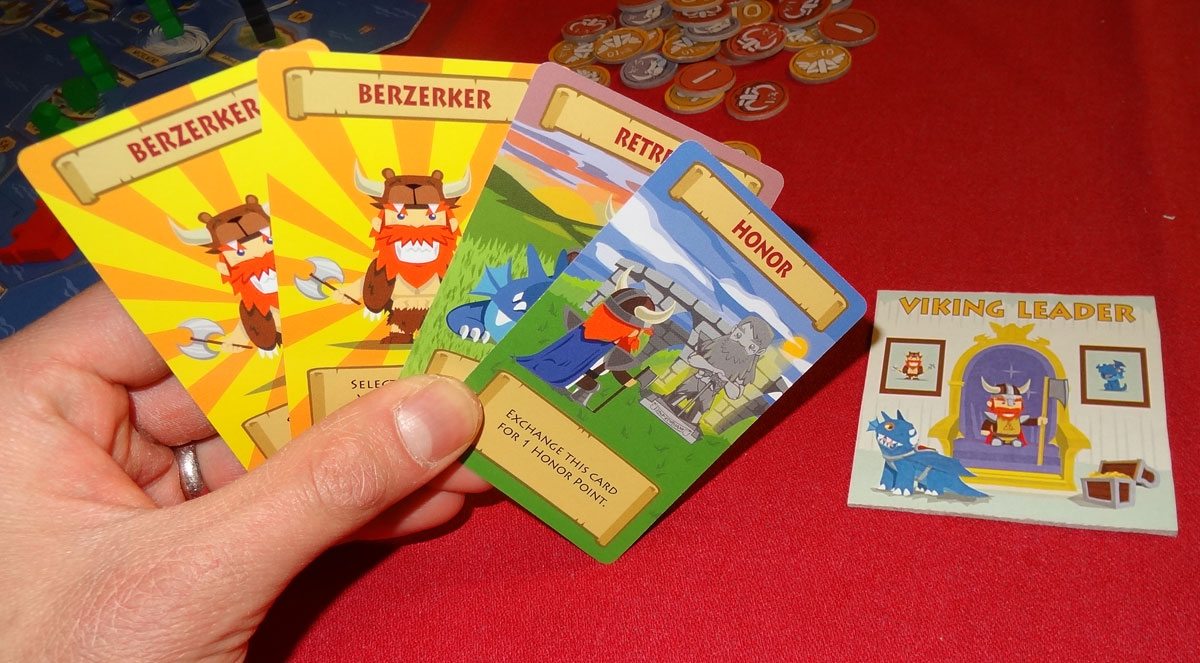
Finally, there’s one card in the deck that can be traded in for an Honor Point, but it costs you an action to do so.
If, during your turn, you have 8 Honor Points, then you win the game.
The Verdict
Vikings of Dragonia is pretty easy to learn, and plays quickly once you’ve learned the various actions. However, even though there are a limited number of things you can do, it still provides some challenging choices to make throughout the game. I think it’s one that casual gamers could enjoy learning, but more experienced gamers will be able to discover some depth to it.

No matter how many players you have, there are not quite enough islands out there for everyone, which means that eventually you’ll need to fight or buy some Honor Points, probably both. What you’ll quickly discover is that managing your three actions is just as important (or possibly even more important) than how much money you have. You’ll need money, of course, to get more Vikings and buy more islands, and of course you’ll want to get a lot of money to buy some Honor Points if you can, but having the money won’t help you if you run out of actions to spend them.
I found that when I played it, I was constantly forgetting to do something. Sometimes I was so focused on getting Vikings and moving them off to the islands that I forgot I could buy Power cards. And then I remembered to buy Power cards, but kept forgetting to move the Wild Dragon to keep another player from getting ridiculous amounts of income each turn. You’ll basically feel like you never have enough actions to do all the things you want to do, but that’s a great limitation to have in the game because it forces you to make those choices. And, of course, everyone else is stuck in the same boat.
I like the trade-off that happens with the Wild Dragons. Early in the game, when money is more scarce, everyone tends to move the dragon away from themselves so they can collect all of their income from their islands. But later in the game, you see the value of having the dragon next door, because those islands are worth points.
Another consequence of the Wild Dragons is that it makes a difference whether you try to spread out your Vikings or concentrate on a smaller area. It’ll take fewer actions to camp out on a few islands close to each other, but then a single dragon could wipe out most of your income. If you spread yourself out, though, then it takes forever to get there and you spend a lot of time just in transit.
So far I’ve only played a few times, but I can already see that there are things that will take me a few more plays before I can really form better strategies. Even your initial placement makes a difference, but it takes a play or two before you can evaluate the randomized board setup to see where you want to go. I think it would be fun with even more players but I can also see that it could get chaotic trying to predict who’s going to attack you next.
The cards are an interesting aspect–they do introduce some luck to the game in the luck of the draw, but the fact that you can buy cards means that you can always accumulate more if you want better odds. The one thing I’m not sure I like is the Honor Point card–it seems too random that you have a 1 in 54 chance (each time through the deck) to buy an Honor Point for only 2 coins.
Overall, though, I’ve had fun playing Vikings of Dragonia. Because there’s a lot of direct attacks, it’s one that you’ll want to play with people who don’t take games personally. If you play with your kids, make sure they can handle that sort of direct competition.
You can find out more about the game at the Kickstarter page.
